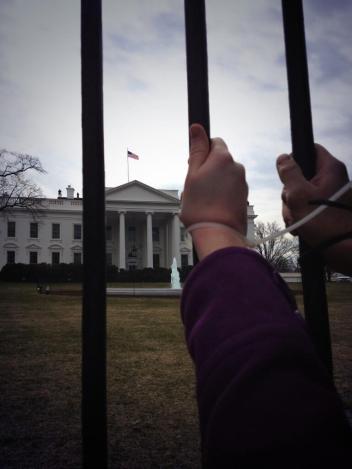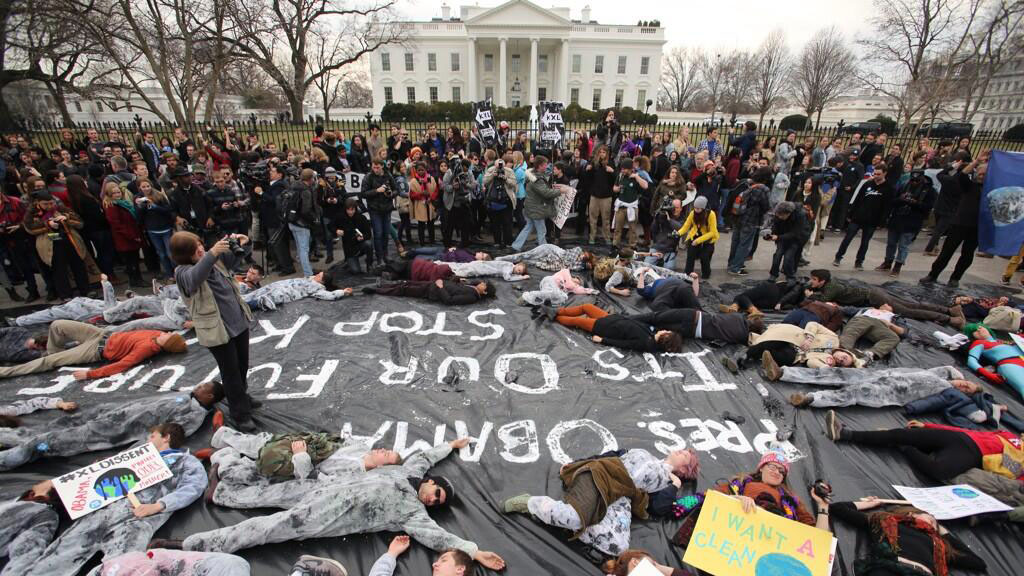Maria Langholz hadn’t been to class all week. As a regional organizer for Sunday’s big Keystone XL pipeline protest at the White House, she had transportation to Washington, D.C., to wrangle for 46 other people, with rumors of a snowstorm on its way to prettify and petrify the highways of the east coast. She had to pack a weekend bag suitable for sleeping in a church basement. She had to figure out how she was going to carry $10,000 in various denominations inconspicuously on her person, because she had been informed, in no uncertain terms, that the county lockup was cash only, and only took exact change. She had never been arrested before.
On Thursday morning, Langholz was still in Minnesota, where she is in the process of navigating that tricky balance between majoring in environmental science at Macalester College and trying to save the planet. “It’s so soon!” she laughed over the phone. “We’re leaving tomorrow! At least I have food covered. I made hummus. And scones. And cookies.”
All across the country, people like Langholz, mostly young, mostly college students, working with the group XL Dissent, were getting ready to get arrested on Sunday. Several of them, like Langholz, had signed a Pledge of Resistance months earlier to engage in peaceful civil disobedience to prevent Keystone from being approved. They would meet in Washington and march to the White House. Some of them would carry an enormous mock pipeline. Others would lay out an enormous, theatrical oil spill and pretend to die on it. Others would lock themselves to the fence surrounding the White House. They would hope, earnestly, for good weather and for the president to notice them.
In Vermont, over a thousand miles away from Langholz, Aly Johnson-Kurts was also packing. “All you need to do to become convinced that climate change is real is to come up here and see the trees,” she said. “The farmers have known. Anyone in food production has known. We have 500 trees that we tap for maple syrup every year. This was a big part of my childhood. Carrying sap. Boiling all night. We don’t even know if we’re going to tap out this year.”
Johnson-Kurts takes a breath, and then keeps going. “Fossil fuel is subsidized. The level of subsidies just for extraction, transportation, refining — and then pollution. No other industry gets to pollute for free. Imagine if we shifted those subsidies. If you’re a restaurant, you can’t put trash out and expect someone to clean it up for you.”
Johnson-Kurts is another environmental studies major, this time in environmental economics and policy, at Smith College. “A pipeline is an investment. We can’t afford these investments. As young people who elected Obama, we made the difference. As youth we elected you, and we are the people who are going to be incredibly impacted by climate change.”
Early on in the 20-hour drive between Minnesota and Washington, D.C., that Langholz was organizing, it began to snow. One of the cars in the caravan got into a car accident, though no one was hurt. In Wisconsin, two semi trucks crashed into each other, and traffic slowed to a crawl. Still, Langholz and the 46 made it to Washington, D.C., in time to go through the protest training on Saturday evening at the Thurgood Marshall Center. Johnson-Kurts made it too. “Just in terms of the numbers …” she said. “Holy Moley!” So many people had arrived that half of them were told to go away and come back later — the organizers would run a second training once the first one was over.
The training was run by the DC Action Lab, a cooperative that has made a specialty out of organizing big protests to run smoothly. XL Dissent was expecting between 300 and 500 arrests the next day, depending. The D.C. police department had agreed to fine each protester $50, instead of $100, but they also told the protesters that if they were planning on locking themselves to the White House fence, they’d better do it with plastic zip ties. Anything that had to be sawed off or broken open could scratch the White House fence, and scratching the White House fence was a felony.
The group was told to arrive the next day with as little as possible –just an ID card, and cash for bail, and a little extra cash for emergencies. Everything they had would be confiscated during booking. The more stuff people had to confiscate, the longer being arrested would take. Don’t bring your phone, they said. The police might search it. People came up on stage and role-played getting arrested in front of the crowd.
The next morning, Langholz, Johnson-Kurts, and 1,200 people gathered in Lafayette Square — a park that had once been a part of the White House grounds, but was separated in 1804 and turned into, in succession, a race track, a graveyard, a zoo, a slave market, a military encampment, and then, eventually, a park again. The sun was shining and the crowd was giddy.
After much discussion, the oil-spill group had decided to make their fake oil spill out of heavy black plastic instead of fabric, since someone had researched and found that the only black fabric they could afford was mostly plastic anyway. They stretched out the spill in front of the White House fence, arranged fake birds around themselves, and lay down on their spill to fake die. Langholz walked past the spill and zip-tied one wrist to the White House fence.
It was around 12:30 in the afternoon, and around her, hundreds of people that she had just met that morning, or the day before, or organizing over the internet, stepped forward and did the same. Hardly anyone was 25, let alone 30. In between the protest chants, conversations began to break out along the fence — old friends, and people meeting each other for the first time. The group chanted: “1,700 miles of pipe! 1,700 miles we’ll fight! No KXL! No KXL!”
After so much worrying over the last week about felonious fence-scratching, she was surprised to discover the fence surrounding the White House was so rusted and peeling that it was hard to imagine scratching it in a way that anyone would even notice. Every time someone moved their zip-tied wrist, flecks of paint separated from the rust and drifted downward onto the White House lawn.
Through the bars, Langholz could see the White House. It looked pretty much like it had on television, but with men carrying huge guns patrolling the lawn.
It began to rain. The police arrested the oil spill first, starting at around 2:30 p.m. They moved politely and efficiently, but it was a big oil spill, and it was clear this was going to take a while. It kept raining. The group kept chanting. “Stand up and organize! No KXL! No compromise!”
The police finished arresting the oil spill and moved on to the fence. They started at one end and worked their way down, arresting four people at a time, and as people were arrested, those who had raincoats took them off and handed them to others who were still zip-tied to the fence. The group kept chanting. “President Obama, President Obama, what you gonna do? Stop this pipeline! Stop this pipeline!”
Three hours after Langholz first zip-tied herself to the fence, the police arrested her. They were polite and efficient. “OK,” she heard one of them say. “We have another one of these on the schedule for next week.” She wondered how much of their time they spent arresting protesters.

Courtesy Aly Johnson-Kurts
The police cut off the zip tie holding her to the fence, which was a relief, and then cuffed her hands behind her back with a larger, more uncomfortable zip tie, which wasn’t. They took her picture, then loaded her into a police van and drove her to a section of the lockup that had been set up just to handle the protesters. They gave her some paperwork to fill out, and then put in her a jail cell, where she sat for five minutes, before she was called out to pay her $50 fine.
And with that, Langholz walked back out the door of the Anacostia Station a free woman, with nothing on her mind but how drive 20 hours back to Minnesota in a snowstorm. She had mixed feelings about how carefully it had all been planned with the police, but she was relieved. It had gone well.
Johnson-Kurts was one of the last people to be arrested — number 307 out of 398. “The last 100,” she said, “went really smoothly.” She had been locked to the fence for six hours in the rain, but at least someone had loaned her a glove to cover the hand that she had zip tied to the fence. The crowd was still chanting. “Obama come out, we’ve got some stuff to talk about!”
The sky had darkened, and the lights inside the White House were flickering on. Word at the protest was that an inside source at the White House disclosed that the president was home, which meant that he could at least hear them. The police said he was there, too.
Langholz hoped the message had gotten across. “It’s not, ‘This is what we want,'” she explained. “It’s not just ‘Oh hi! We care about this!’ This is what we’re demanding.” She paused. “He didn’t come outside and say hello. But we knew he was there.”


